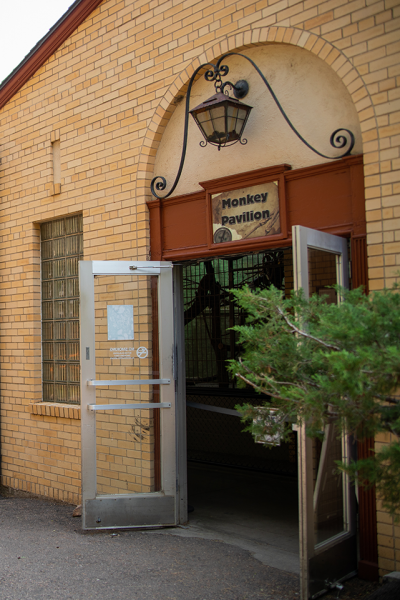Cheyenne Mountain Zoo is moving forward with plans to demolish Monkey Pavilion, located centrally near the Zoo’s eateries and historic carousel, starting in November. Monkey Pavilion was built in 1942 and originally housed big cats, such as tigers, leopards and lions. Since then, the building has undergone renovations to support residents including lemurs, monkeys, sloths and more.
Since their inception, zoos have modernized in leaps and bounds. Fostering relationships between our guests and animals is our top priority, supported by our focuses on animal care, conservation and education. The animals’ homes play a vital role in our ability to achieve our goal of helping people fall in love with wildlife and wild places. We understand perception matters. We want to inspire our guests, and have seen that if an enclosure presents too many barriers, our ability to foster those connections is limited.
While the building provided good homes and enriching experiences for the animals that lived there, it falls short of providing an environment that helps our keepers build connections between guests and animals. We see opportunities for better use of the area. The possibilities seem endless, and we are considering every idea. We have not yet made decisions about the future of the space, but will announce them when the time is right.
The building, once considered architecturally beautiful and state-of-the-art, has become a symbol of zoos past, and its design does not reflect who we are today. We acknowledge that Monkey Pavilion is an iconic building at Cheyenne Mountain Zoo. Many longtime guests, members and staff have childhood photos by the outdoor exhibits or with the nearby zebra and lioness statues, which will be relocated within the Zoo. Its now-dated design is a nod to the progress Association of Zoos and Aquariums-accredited modern zoos have made since its construction, and its demolition is further evidence of the importance we place on providing the best possible opportunities for our guests to fall in love with animals, without distracting barriers.
Embracing our past, and learning from it, strengthens our future potential. It highlights how far we’ve come through positive changes across the zoo profession, and it encourages us to keep striving for additional change that will make us even better in the future.
Of course, demolishing this building requires a lot of coordination, and our animals’ best interests are at the heart of our planning, along with ensuring our guests’ experiences aren’t negatively impacted by the building’s removal. Some current Monkey Pavilion residents will move to other spaces at Cheyenne Mountain Zoo. For others, we have identified new homes at other AZA-accredited facilities. The building will continue to empty over the next month and a half, with the building closing October 28, 2020.
Demolition is slated to begin in November and is expected to take several months. We will keep you posted as we make progress on this historic update to our Zoo.
About Cheyenne Mountain Zoo
Cheyenne Mountain Zoological Society was founded in 1926. Today, Cheyenne Mountain Zoo, America’s mountain Zoo, offers comprehensive education programs, exciting conservation efforts and truly fantastic animal experiences. In 2020, Cheyenne Mountain Zoo was voted #4 Best Zoo in North America and CMZoo’s Rocky Mountain Wild was named #2 Best Zoo Exhibit in North America by USA TODAY 10Best Readers’ Choice Awards. It is Cheyenne Mountain Zoo’s goal to help guests fall in love with animals and nature, and take action to protect them. Of the 233 zoos and aquariums accredited by the Association of Zoos and Aquariums (AZA), Cheyenne Mountain Zoo is one of just a few operating without tax support. Cheyenne Mountain Zoo depends on admissions, membership dues, special event attendance and donations for funding.

